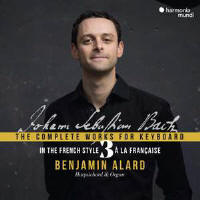Texte paru dans: / Appeared in: |
|
|
Outil de traduction (Très approximatif) |
|
|
Reviewer:
Lindsay Kemp Benjamin Alard’s project to record Bach’s complete works for harpsichord and organ is an awesome one; there must be few who have attempted it, or indeed who could. Add to that his ingenious approach, presenting in 17 volumes Bach’s development in chronological sequence enhanced by occasional examples of works by some of the composers who influenced him, and you have the potential for something very special and revealing, a real journey to be savoured over a period of years. With Vol 3 Alard reaches Bach’s years as court organist and chamber musician at Weimar from 1708 to 1717, during which he entered what is often considered his early maturity. Alard’s focus here is on Bach’s interest in and early encounters with the French style, the most obvious reflection of which lies in the harpsichord suites which dominate two of the three discs. They include the two suites similar to the so-called French Suites, three of the English Suites (No 1 in an early version) and the E minor Lute Suite, BWV996 (in all likelihood really a keyboard piece). The French influence in these pieces is obvious, but needless to say Bach’s character and German background are evident. The Frenchness of the organ chorales is less clear at first, until Alard drops in a chantbased piece by Nicolas de Grigny. The connections are then cemented by setting the great Passacaglia in C minor alongside the little piece by André Raison that supplied its theme. The way Alard’s programming revels in such juxtapositions, rather than just spilling out Bach’s music in the familiar genre groupings, is one of the most fascinating features of this whole project. He uses a different instrument for each disc: the gorgeous, fruity, deep-toned French harpsichord from Château d’Assas; a copy of a German harpsichord whose mellow tone makes a nice ‘lutey’ sound for BWV996; and the Andreas Silbermann French-style organ in the Abbaye Saint-Étienne in Marmoutier, Alsace, which has the solidly differentiated and feisty colours to bring out the best not just in the great Passacaglia but in the interlacing lines of the chorales as well. I enjoyed Alard’s playing on the organ more, in fact; despite the big sounds being unleashed there is a cleanness and a quality of light here, superbly captured by the recording, that keeps everything clear, coherent and involving. His harpsichord-playing is in many ways no less distinguished, likewise prizing clarity and elegance over show, even when delivering the organy flourishes of BWV818a’s Prélude. There is a precision to his touch that avoids hardness, and a proper respect for tone-quality. But there were quite a few times when I wished for more flexibility of tempo, particularly in dance movements, and I also felt Alard could have experimented with inégale and varied his ornamentation more. But he is a classy player, and this is certainly a project with the potential to tell us much about its noble subject. Definitely worth following. |
|




